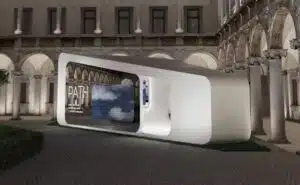Every car enthusiast has his or her list, and every car magazine - print or digital - has made its list sooner or later. We want to frame the issue from the specific point of view of car design, choosing the eight cars that innovated the style of their era, shaping the public's tastes and thus the production of the automotive industry. If you too have a passion for cars and the designhere you can find the programme of our Master in car design So here are our eight champions, in strict alphabetical order so as not to play favorites.
1. Alfa Romeo 33 Stradale
Manufactured as a one-off in the late 1960s, only 18 examples were produced. It was the public-facing version of the Tipo 33, a competition car competing in the World Sport Prototype Championship. Designed by Franco Scaglione, it had a mid-mounted aluminium alloy V8 engine with a 1995 cc displacement and a maximum power output of 230 hp obtained at the then stratospheric 8800 rpm. In short, not only a jewel of designbut also mechanics.
2. Bugatti Type 57
Produced between 1934 and 1940 it was a design by Jean Bugattison of patron Ettore, the bodywork was completed according to each customer's specifications and was mounted on an innovative chassis that was also used in competition. Produced in around 700 examples, it was a great commercial success for the French yard, although it was a luxury car that was certainly not within the reach of the middle classes. The Type 57 It was produced in saloon, coupé, roadster and cabriolet variants; plus a few examples specially prepared for track racing. The best preserved models are valued at up to 25 million euros.
3. Chevrolet Corvette
Produced since 1953, it is now in its seventh generation - one of the longest-lasting models in the history of world motoring. It was the first two-seater sports car made in the USA. The Corvette fits right into the American tradition of the simple cars, strong, light but with large-capacity engines. Designed by Harley Earl It owes its name to the navy nomenclature, which defines small, fast and manoeuvrable naval units as corvettes. The engine was a 4.6-litre V6 developing 290 hp, powered by a battery of three carburettors. The transmission was a two-speed automatic. The body was made of fibreglass.
4. Citroen DS
The success of this model is well illustrated by the fact that you can still see a few examples in the streets of our cities today, always eliciting smiles of appreciation and looks of admiration. Produced from 1955 to 1975, it was a high-end model that adopted a series of engineering solutions that were revolutionary for the time and are still used by many manufacturers today. The front-wheel drive, the hydropneumatic suspensions and especially the bodywork, which was the result of careful aerodynamic studies. Two Italians figured in the design team that gave birth to the DS: the designer Flaminio Bertoni and engine expert Walter Becchia. The acronym DS had a double meaning: it stood for Désirée Spéciale and pronounced all at once sounded like déesse, which means 'goddess' in French. Certainly an apt choice for what became the French yard's flagship and one of the most memorable cars ever produced.
5. Jaguar E-Type
Produced from 1961 to 1975, it was a revolutionary car in terms of its design features, aesthetics and the driving pleasure it conveyed. Its extraordinary success was also due to its selling price, which was lower than that of competing cars. During its life cycle it sold 70,000 units. In 2004, Sports Cars International magazine crowned it the queen of 1960s sports cars. Designed by Malcolm SayerIt was among the first cars to use a monocoque chassis, on which was mounted a 3.8-litre engine capable of generating 265 horsepower, which pushing on the rear axle (with independent wheel suspension) made the car fly at 240 km per hour. Adored by collectors, today a well-preserved model can fetch up to 60,000 euros.
6. Lamborghini Countach
Designed by engineer Paolo Stanzani, it was designed by Marcello Gandiniwho had already created the Miura and would later give birth to the Lancia Stratos. It debuted as a prototype in 1971 and was produced for almost 20 years. The distinctive feature of the car, apart from its wedge-shaped design, was the vertical opening of the doors. This mechanism was chosen for a strictly functional reason, as the car was already very wide in terms of body, and traditional side-opening doors would have meant serious difficulties in parking. The body of the car was aluminium with a tubular steel frame. A choice that, in the face of complicated workmanship, guaranteed lightness and a low centre of gravity. The engine was a 4-litre V12, mounted longitudinally, with the gearbox positioned towards the front, in the cockpit, and the drive shaft positioned towards the rear. This engineering choice, which subverted the normal mechanical layout, was made in order to centralise the car's centre of gravity as much as possible and thus obtain great dynamic advantages. The name of the car comes not from a breed of bull, as is usually the case in house Lamborghinibut from an expression of astonishment and admiration typical of the Piedmontese dialect. Legend has it that this expression was spontaneously used by a night watchman when he saw the prototype car. An expression of astonishment that millions of people would later pronounce, in many languages, when passing a Lamborghini Countach.
7. Mercedes 300 SL Gullwing
It is the progenitor of the SL series, which stands for 'Sport Leicht' (light sport) series of fast and elegant Mercedes cars. It was produced for only three years, from 1954 to 1957, but that was enough to make it a legend. The person in charge of the project, with which the manufacturer aimed to return to the sporting splendour of pre-World War II times, was Rudolf Uhlenhaut, who created the 300 SL racing car, powered by a 3-litre straight-six engine. The car was a successful design right from the start, winning almost every competition it entered. The solution of the doors opening like gull wings was due to the particular car chassismade of tubular latticework, which was both light and rigid. However, this solution had the disadvantage of being bulky, especially along the sides, prompting the designers to invent a new solution to allow the driver access. The road version of the track car was strongly desired by Mercedes' American importer, Max Hoffman, who demanded a road-legal model and pledged to buy 100 examples. For the engine of the road version, they opted for a solution derived from aeronautics, direct injection, instead of the classic carburettors. This solution was a success above all in terms of performance; in the production version the car reached 215 hp and 250 km/h.
8. Porsche 356
It is the first production model produced by the Stuttgart-based manufacturer, called 'superlight' by enthusiasts because of its bodywork made entirely of hand-wrought aluminium on a male wooden mould. Produced from 1948 to 1965 it originally had an air-cooled 1100 cc rear engine, which was later increased to 2000 cc. It was a unit directly derived from the Volkswagen power unit that powered the Beetle, not surprisingly a car designed by Ferdinand Porsche himself. The car's strengths were its handling, lightness, road-holding and, above all, reliability. A total of 76,000 examples of this jewel on four wheels were built, about half of which are still on the road. The model that is most popular with collectors is the cabriolet, which if in good condition has a market price of around 60,000 euros.
For information on upcoming editions of the master's degree in Car Design click here.




